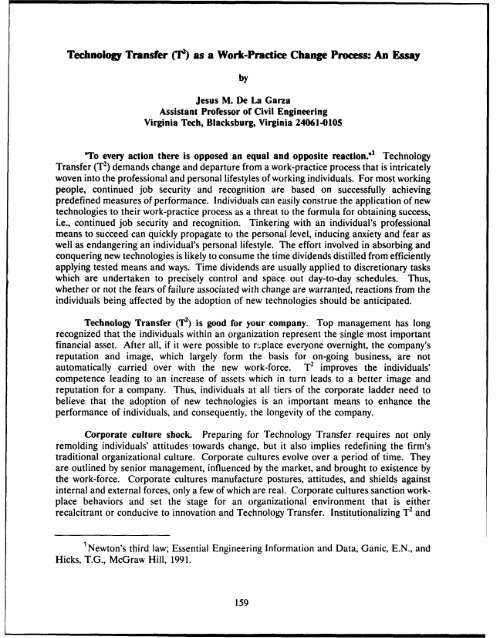Challenges and Opportunities for Innovation in the Public Works ...
Challenges and Opportunities for Innovation in the Public Works ...
Challenges and Opportunities for Innovation in the Public Works ...
Create successful ePaper yourself
Turn your PDF publications into a flip-book with our unique Google optimized e-Paper software.
Technology Transfer (T) as a Work-Practice Change Process: An Essay<br />
by<br />
Jesus M. De La Garza<br />
Assistant Professor of Civil Eng<strong>in</strong>eer<strong>in</strong>g<br />
Virg<strong>in</strong>ia Tech, Blacksburg, Virg<strong>in</strong>ia 24061-0105<br />
"To every action <strong>the</strong>re is opposed an equal <strong>and</strong> opposite reaction." Technology<br />
Transfer (T-) dem<strong>and</strong>s change <strong>and</strong> departure from a work-practice process that is <strong>in</strong>tricately<br />
woven <strong>in</strong>to <strong>the</strong> professional <strong>and</strong> personal lifestyles of work<strong>in</strong>g <strong>in</strong>dividuals. For most work<strong>in</strong>g<br />
people, cont<strong>in</strong>ued job security <strong>and</strong> recognition are based on successfully achiev<strong>in</strong>g<br />
predef<strong>in</strong>ed measures of per<strong>for</strong>mance. Individuals can easily construe <strong>the</strong> application of new<br />
technologies to <strong>the</strong>ir work-practice process as a threat to <strong>the</strong> <strong>for</strong>mula <strong>for</strong> obta<strong>in</strong><strong>in</strong>g success,<br />
i.e., cont<strong>in</strong>ued job security <strong>and</strong> recognition. T<strong>in</strong>ker<strong>in</strong>g with an <strong>in</strong>dividual's professional<br />
means to succeed can quickly propagate to <strong>the</strong> personal level, <strong>in</strong>duc<strong>in</strong>g anxiety <strong>and</strong> fear as<br />
well as endanger<strong>in</strong>g an <strong>in</strong>dividual's personal lifestyle. The ef<strong>for</strong>t <strong>in</strong>volved <strong>in</strong> absorb<strong>in</strong>g <strong>and</strong><br />
conquer<strong>in</strong>g new technologies is likely to consume <strong>the</strong> time dividends distilled from efficiently<br />
apply<strong>in</strong>g tested means <strong>and</strong> ways. Time dividends are usually applied to discretionary tasks<br />
which are undertaken to precisely control <strong>and</strong> space out day-to-day schedules. Thus,<br />
whe<strong>the</strong>r or not <strong>the</strong> fears of failure associated with change are warranted, reactions from <strong>the</strong><br />
<strong>in</strong>dividuals be<strong>in</strong>g affected by <strong>the</strong> adoption of new technologies should be anticipated.<br />
Technology Transfer (T1`2) is good <strong>for</strong> your company. Top management has long<br />
recognized that <strong>the</strong> <strong>in</strong>dividuals with<strong>in</strong> an organization represent <strong>the</strong> s<strong>in</strong>gle most important<br />
f<strong>in</strong>ancial asset. After all, if it were possible to r,;place everyone overnight, <strong>the</strong> company's<br />
reputation <strong>and</strong> image, which largely <strong>for</strong>m <strong>the</strong> basis <strong>for</strong> on-go<strong>in</strong>g bus<strong>in</strong>ess, are not<br />
automatically carried over with <strong>the</strong> new work-<strong>for</strong>ce. T 2 improves <strong>the</strong> <strong>in</strong>dividuals'<br />
competence lead<strong>in</strong>g to an <strong>in</strong>crease of assets which <strong>in</strong> turn leads to a better image <strong>and</strong><br />
reputation <strong>for</strong> a company. Thus, <strong>in</strong>dividuals at all tiers of <strong>the</strong> corporate ladder need to<br />
believe that <strong>the</strong> adoption of new technologies is an important means to enhance <strong>the</strong><br />
per<strong>for</strong>mance of <strong>in</strong>dividuals, <strong>and</strong> consequently, <strong>the</strong> longevity of <strong>the</strong> company.<br />
Corporate culture shock. Prepar<strong>in</strong>g <strong>for</strong> Technology Transfer requires not only<br />
remold<strong>in</strong>g <strong>in</strong>dividuals' attitudes towards change, but it also implies redef<strong>in</strong><strong>in</strong>g <strong>the</strong> firm's<br />
traditional organizational culture. Corporate cultures evolve over a period of time. They<br />
are outl<strong>in</strong>ed by senior management, <strong>in</strong>fluenced by <strong>the</strong> market, <strong>and</strong> brought to existence by<br />
<strong>the</strong> work-<strong>for</strong>ce. Corporate cultures manufacture postures, attitudes, <strong>and</strong> shields aga<strong>in</strong>st<br />
<strong>in</strong>ternal <strong>and</strong> external <strong>for</strong>ces, only a few of which are real. Corporate cultures sanction workplace<br />
behaviors <strong>and</strong> set <strong>the</strong> stage <strong>for</strong> an organizational environment that is ei<strong>the</strong>r<br />
recalcitrant or conducive to <strong>in</strong>novation <strong>and</strong> Technology Transfer. Institutionaliz<strong>in</strong>g T 2 <strong>and</strong><br />
Newton's third law; Essential Eng<strong>in</strong>eer<strong>in</strong>g In<strong>for</strong>mation <strong>and</strong> Data, Ganic, E.N., <strong>and</strong><br />
Hicks, T.G., McGraw Hill, 1991.<br />
159







